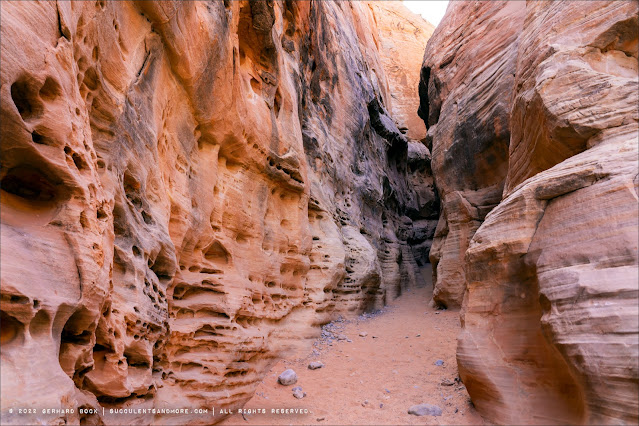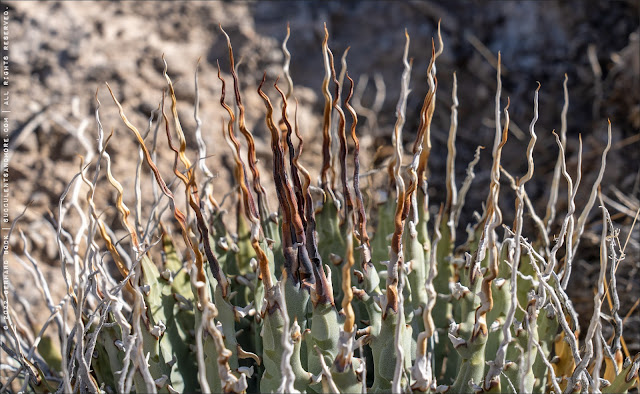I just got back from a 3-day trip to Las Vegas with my friend Justin. I'd been to Las Vegas before, but I'd never done what Justin and I just did: explore the desert around Sin City. I thought I knew what to expect based on the reading and planning I'd done—except that reality exceeded my expectations in every conceivable way. If you think Las Vegas is casinos and unfettered sprawl, you're right, but there's spectacular nature within an easy driving distance. Other than staying in a casino on the Strip, we spent all our daylight hours in the desert wonderlands to the east and west of Las Vegas.
There'll be a bunch of posts down the line, but for now, let me tease you with these photos.
We visited three spectacular areas full of magnificent geology: Red Rock Canyon Conservation Area to the west of Las Vegas, and Golden Butte National Monument and Valley of Fire State Park to the east. What all three have in common are amazing Aztec sandstone rocks formed from sand dunes 150 million years ago.
Red Rock Canyon:
Golden Butte:
Valley of Fire:
But our real focus was on the vegetation. Seeing plants you love in habitat is an exhilarating experience. And we scored big time!
 |
| Desert globemallow (Sphaeralcea ambigua) |
Cacti:
 |
Engelmann's hedgehog (Echinocereus engelmannii)
|
 |
| Echinocereus engelmannii in flower (photo by Justin Thiel) |
 |
| California barrel cactus (Ferocactus cylindraceus) |
 |
| Cotton-top cactus (Echinocactus polycephalus, or Homalocephala polycephala if you accept the new name) |
 |
| Mojave yucca (Yucca schidigera) |
 |
| Banana yucca (Yucca baccata) |
 |
| Eastern form of the Joshua tree (Yucca brevifolia var. jaegeriana) |
More than anything else, what we wanted to see in habitat was Agave utahensis, both var. nevadensis and var. eborispina. And we scored big time!
Agave utahensis var. nevadensis:
 |
| Justin collecting seeds from Agave utahensis var. nevadensis |
Agave utahensis var. eborispina:
 |
| Many agaves start life in the tightest cracks in rocks and can't form a rosette until they're larger |
I'll have a separate posts about these agaves, including more information on how they differ. Because of their often fantastical spines and their general beauty, they're heavily poached in habitat even though plants ripped out of their natural environment often don't reestablish elsewhere. Fortunately, they're easily propagated from seed and generally quite available in the trade.
Other things we saw were man-made, including...
Hoover Dam:
...and one pretty darn amazing garden:
Ethel M. Chocolate Factory Desert Garden:
 |
| Echinocereus triglochidiatus and Agave weberi |
Look for much more desert imagery to come!
RELATED POSTS:
© Gerhard Bock, 2022. All rights reserved. To receive all new posts by email, please subscribe here.











































Love, love, love all these photos! WOW!
ReplyDeleteThanks! This was an epic trip for me. I didn't quite know what to expect, and I was blown away by what we found.
DeleteWow. Gorgeous photos of spectacular scenery. And the plants are the icing on top! How old do you reckon that (ferocactus?) next to Justin is? Thanks for sharing your plant hunting adventure.
ReplyDeleteI asked a friend who knows way more about desert plants than I ever will, and he guesses the Ferocactus cylindraceus to be 50-100 years old, although it could be more because the growing season is shorter there.
DeleteFantastic photos! It looks like you're on the road to becoming a full-fledged plant explorer. Hopefully, it wasn't as hot as the scenery made it appear.
ReplyDeleteI'd love to do more exploring!
DeleteThe weather was very cooperative. High 80s on Saturday, low 80s on Sunday, and in the low 70s on Monday.
Wonderful. What a privilege to see A. utahensis in habitat!
ReplyDeleteWe would have been happy to see even just a handful of eborispina or nevadensis in habitat. To see so many was an unforgettable experience.
DeleteFinally, a reason to visit Las Vegas -- to drop some bags and head for these exquisite destinations! So glad you found your agave quarry!
ReplyDeleteThat's exactly what we did!
DeleteAgave quarry, that about sums it up, doesn't it? Sheer limestone, with tiny pockets of soil.